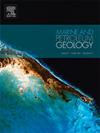CO2驱油过程中方解石在深水砂岩中的溶解机理及其对CO2固存的影响——以鄂尔多斯盆地长7段为例
IF 3.6
2区 地球科学
Q1 GEOSCIENCES, MULTIDISCIPLINARY
引用次数: 0
摘要
制定强有力的创新战略,减少碳排放,应对日益严重的全球气候变化威胁。以方解石为主要胶结材料的深水致密砂岩,是封存二氧化碳的重要储层。然而,方解石的微观溶解机制仍然知之甚少,并可能显著影响地质CO2封存的有效性。研究了深水致密砂岩中方解石的溶蚀行为及其在CO2驱油过程中的体积变化。我们使用了一种新的三维、微米尺度的反应输运模型,其中方解石的分布和几何特征是通过切片铸造和阴极发光图像来了解的。在深水致密砂岩中,方解石颗粒彼此相邻,形成大量微米级方解石聚集体。在CO2驱油过程中,由于溶质迁移限制了整体溶解速率,方解石颗粒的溶解速率发生了变化。方解石聚集体反应为单个颗粒,外表面不断溶解,内表面保持平衡。方解石团聚体的溶解产物在地层水中聚集,抑制了周围方解石的溶解,从而降低了深水致密砂岩方解石的整体溶解速率。大量方解石最初溶解迅速,然后逐渐减慢。这影响了CO2的固存效率和迁移模式。这些发现为研究深水致密砂岩储层中CO2的物理性质和地质力学完整性提供了重要见解,并具有长期储层安全性和环境保护意义。本文章由计算机程序翻译,如有差异,请以英文原文为准。
The dissolution mechanism of calcite and its impact on CO2 sequestration in deep-water sandstone during CO2 flooding: A case study in the Chang 7 member, Ordos Basin, China
Robust and innovative strategies to reduce carbon emissions to address the growing threat of global climate change. Deep-water tight sandstone, with calcite as its primary cementing material, can be an essential reservoir for CO2 sequestration. However, the microscopic dissolution mechanism of calcite is still poorly understood and can significantly impact the effectiveness of geological CO2 storage. We investigated the dissolution behaviours of calcite in deep-water tight sandstone and its volume changes on CO2 during CO2 flooding. We used a novel 3D, micrometric-scale reactive-transport model, where the distribution and geometric characteristics of calcite were informed by section casting and cathode luminescence images. We found that the calcite particles adjacent to each other in deep-water tight sandstone form numerous micrometer-scale calcite aggregates. During CO2 flooding, the dissolution rates of calcite particles vary since solute migration limits the overall dissolution rate. Calcite aggregates react as single particles, with the external surface continuously dissolving and the internal surface maintaining balance. The dissolution products of the calcite aggregates accumulate in the formation water, inhibiting the dissolution of the surrounding calcite and thereby reducing the overall dissolution rate of the deep-water tight sandstone calcite. Large volumes of calcite initially dissolve rapidly, then gradually slow down. This affects the CO2 sequestration efficiency and migration patterns. These findings provide vital insights into the physical properties and geomechanical integrity during CO2 storage in deep-water tight sandstone and have long-term storage security and environmental protection implications.
求助全文
通过发布文献求助,成功后即可免费获取论文全文。
去求助
来源期刊

Marine and Petroleum Geology
地学-地球科学综合
CiteScore
8.80
自引率
14.30%
发文量
475
审稿时长
63 days
期刊介绍:
Marine and Petroleum Geology is the pre-eminent international forum for the exchange of multidisciplinary concepts, interpretations and techniques for all concerned with marine and petroleum geology in industry, government and academia. Rapid bimonthly publication allows early communications of papers or short communications to the geoscience community.
Marine and Petroleum Geology is essential reading for geologists, geophysicists and explorationists in industry, government and academia working in the following areas: marine geology; basin analysis and evaluation; organic geochemistry; reserve/resource estimation; seismic stratigraphy; thermal models of basic evolution; sedimentary geology; continental margins; geophysical interpretation; structural geology/tectonics; formation evaluation techniques; well logging.
 求助内容:
求助内容: 应助结果提醒方式:
应助结果提醒方式:


